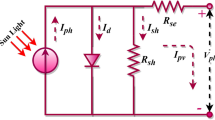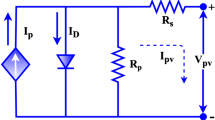Abstract
The appropriate selection of parameters of photovoltaic models is necessary for an accurate evaluation, control, and optimization of photovoltaic systems. Even though various strategies have been developed to address this issue, but, a precise and reliable scheme for identifying the model parameters remains a challenge. To improve parameter identification of different photovoltaic models, an opposition-based learning reptile search algorithm with Cauchy mutation strategy (OBL-RSACM) is introduced in this research. In OBL-RSACM, the individuals in search space get doubled by generating their opposite guess of the solution which overcomes the issue of strucking of solution in local minima and also enhances the convergence speed. Cauchy mutation strategy is also incorporated in the basic reptile search algorithm (RSA) which enhances the search mechanism, modifies the control parameter, mutation-driven scheme, and greedy approach of selection during the search process of the RSA. Thus, improves the exploration process and maintains the proper balance between exploration and exploitation. The proposed OBL-RSACM is applied to estimate the parameters of different photovoltaic models, i.e., single diode, double diode, and photovoltaic module. A comprehensive comparison of experimental results and analysis demonstrated that OBL-RSACM outperformed other state-of-the-art algorithms in terms of accuracy, reliability, and computational efficacy.








Similar content being viewed by others
Data availability statement
The datasets generated during and/or analysed during the current study are available from the corresponding author on reasonable request.
Abbreviations
- \(I_{out}\) :
-
Output current
- \(I_{photo}\) :
-
Photo generated current source
- \(I_{shunt}\) :
-
Shunt resistance current
- \(I_{diode}\) :
-
Diode current
- \(R_{sh}\) :
-
Shunt resistance
- \(R_{s}\) :
-
Series resistance
- \(I_{sat}\) :
-
Reverse saturation current
- \(V_{0ut}\) :
-
Output voltage
- \(n\) :
-
Diode ideal factor
- \(k\) :
-
Boltzmann constant
- \(q\) :
-
Magnitude of charge
- \(T\) :
-
Temperature
- \(I_{diode1}\) :
-
First diode current
- \(I_{diode2}\) :
-
Second diode current
- \(I_{sat1}\) :
-
Diffusion currents
- \(I_{sat2}\) :
-
Saturation currents
- \(NP\) :
-
Number of populations
- \(D\) :
-
Dimension
- RSA:
-
Reptile search algorithm
- OBL:
-
Opposition based learning
- CM:
-
Cauchy mutation
- RMSE:
-
Root mean square error
References
Abbassi R, Abbassi A, Jemli M, Chebbi S (2018) Identification of unknown parameters of solar cell models: a comprehensive overview of available approaches. Renew Sustain Energy Rev 90(February):453–474. https://doi.org/10.1016/j.rser.2018.03.011
Abbassi A, Ben Mehrez R, Bensalem Y, Abbassi R, Kchaou M, Jemli M, Abualigah L, Altalhi M (2022a) Improved arithmetic optimization algorithm for parameters extraction of photovoltaic solar cell single-diode model. Arab J Sci Eng. https://doi.org/10.1007/s13369-022-06605-y
Abbassi A, Ben Mehrez R, Touaiti B, Abualigah L, Touti E (2022b) Parameterization of photovoltaic solar cell double-diode model based on improved arithmetic optimization algorithm. Optik 253(January):168600. https://doi.org/10.1016/j.ijleo.2022.168600
Abd W, Maguid E, Abdel HM, Abdeltwab S, Saleh AA (2022) Fractional order Darwinian particle swarm optimization for parameters identification of solar PV cells and modules. Alex Eng J 61(2):1249–1263. https://doi.org/10.1016/j.aej.2021.06.019
Abdel-basset M, El-shahat D, Chakrabortty RK, Ryan M (2021) Parameter estimation of photovoltaic models using an improved marine predators algorithm. Energy Convers Manag 227(May 2020):113491. https://doi.org/10.1016/j.enconman.2020.113491
Abualigah L, Diabat A, Mirjalili S, Abd Elaziz M, Gandomi AH (2021a) The arithmetic optimization algorithm. Comput Methods Appl Mech Eng 376:113609. https://doi.org/10.1016/j.cma.2020.113609
Abualigah L, Yousri D, Abd Elaziz M, Ewees AA, Al-qaness MAA, Gandomi AH (2021b) Aquila optimizer: a novel meta-heuristic optimization algorithm. Comput Ind Eng 157(October 2020):107250. https://doi.org/10.1016/j.cie.2021b.107250
Abualigah L, Abd M, Sumari P, Woo Z (2022) Reptile search algorithm (RSA): a nature-inspired meta-heuristic optimizer. Expert Syst Appl 191(November 2021):116158. https://doi.org/10.1016/j.eswa.2021.116158
Agushaka JO, Ezugwu AE, Abualigah L (2022) Dwarf mongoose optimization algorithm. Comput Methods Appl Mech Eng 391:114570. https://doi.org/10.1016/j.cma.2022.114570
Al-Shourbaji I, Helian N, Sun Y, Alshathri S, Elaziz MA (2022) Boosting ant colony optimization with reptile search algorithm for churn prediction. Mathematics 10(7):1–21. https://doi.org/10.3390/math10071031
Chauhan S, Vashishtha G (2021) Mutation-based arithmetic optimization algorithm for global optimization. 2021 International Conference on Intelligent Technologies (CONIT) Karnataka, India., June, 1–6
Chauhan S, Singh M, Agarwal AK (2019) Crisscross optimization algorithm for the designing of quadrature mirror filter bank. 2019 2nd international conference on intelligent communication and computational techniques, ICCT 2019, pp 124–130. https://doi.org/10.1109/ICCT46177.2019.8968779
Chauhan S, Singh M, Aggarwal AK (2020a) Diversity driven multi-parent evolutionary algorithm with adaptive non-uniform mutation. J Exp Theor Artif Intell. https://doi.org/10.1080/0952813X.2020.1785020
Chauhan S, Singh M, Kumar Aggarwal A (2020b) An effective health indicator for bearing using corrected conditional entropy through diversity-driven multi-parent evolutionary algorithm. Struct Health Monit. https://doi.org/10.1177/1475921720962419
Chauhan S, Singh B, Singh M (2021a) Modified ant colony optimization based PID controller design for coupled tank system. Eng Res Express 3(4):045005. https://doi.org/10.1088/2631-8695/ac2bf3
Chauhan S, Singh M, Aggarwal AK (2021b) Bearing defect identification via evolutionary algorithm with adaptive wavelet mutation strategy. Measurement 179(December 20201):109445. https://doi.org/10.1016/j.measurement.2021b.109445
Chauhan S, Singh M, Aggarwal AK (2021c) Cluster head selection in heterogeneous wireless sensor network using a new evolutionary algorithm. Wirel Pers Commun 119(0123456789):585–616. https://doi.org/10.1007/s11277-021-08225-5
Chauhan S, Singh M, Aggarwal AK (2021d) Design of a two-channel quadrature mirror filter bank through a diversity-driven multi-parent evolutionary algorithm. Circuits Syst Signal Process. https://doi.org/10.1007/s00034-020-01625-1
Chauhan S, Vashishtha G, Kumar A (2021e) A symbiosis of arithmetic optimizer with slime mould algorithm for improving global optimization and conventional design problem. J Supercomput. https://doi.org/10.1007/s11227-021-04105-8
Chen X, Xu B, Mei C, Ding Y, Li K (2018) Teaching-learning-based artificial bee colony for solar photovoltaic parameter estimation. Appl Energy 212(October 2017):1578–1588. https://doi.org/10.1016/j.apenergy.2017.12.115
Cherukuri SK, Kumar BP, Kaniganti KR, Muthubalaji S, Devadasu G, Babu TS, Alhelou HH (2022) A novel array configuration technique for improving the power output of the partial shaded photovoltaic system. In: IEEE Access, vol 10. pp 15056–15067. https://doi.org/10.1109/ACCESS.2022.3148065
Elkholy A, El-ela AAA (2019) Heliyon Optimal parameters estimation and modelling of photovoltaic modules using analytical method. Heliyon 5(October 2018):e02137. https://doi.org/10.1016/j.heliyon.2019.e02137
Gao S, Wang K, Tao S, Jin T, Dai H, Cheng J (2021) A state-of-the-art differential evolution algorithm for parameter estimation of solar photovoltaic models. Energy Convers Manag 230(December 2020):113784. https://doi.org/10.1016/j.enconman.2020.113784
Grisales-nore LF (2022) Parametric estimation in photovoltaic modules using the crow search algorithm. Int J Electr Comput Eng (IJECE) 12(1):11591. https://doi.org/10.11591/ijece.v12i1.pp82-91
Kharchouf Y, Herbazi R, Chahboun A (2022) Parameter ’ s extraction of solar photovoltaic models using an improved differential evolution algorithm. Energy Convers Manag 251(November 2021):114972. https://doi.org/10.1016/j.enconman.2021.114972
Kler D, Goswami Y, Rana KPS, Kumar V (2019) A novel approach to parameter estimation of photovoltaic systems using hybridized optimizer. Energy Convers Manag 187(July 2018):486–511. https://doi.org/10.1016/j.enconman.2019.01.102
Kumar BP, Cherukuri SK, Kaniganti KR, Karuppiah N, Muniraj R, Babu TS, Alhelou HH (2022) Performance enhancement of partial shaded photovoltaic system with the novel screw pattern array configuration scheme. In: IEEE Access, vol 10. pp 1731–1744. https://doi.org/10.1109/ACCESS.2021.3138917
Li C, Mao Y, Zhou J, Zhang N, An X (2017) Design of a fuzzy-PID controller for a nonlinear hydraulic turbine governing system by using a novel gravitational search algorithm based on Cauchy mutation and mass weighting. Appl Soft Comput J 52:290–305. https://doi.org/10.1016/j.asoc.2016.10.035
Oyelade ON, Ezugwu AES, Mohamed TIA, Abualigah L (2022) Ebola optimization search algorithm: a new nature-inspired metaheuristic optimization algorithm. IEEE Access 10:16150–16177. https://doi.org/10.1109/ACCESS.2022.3147821
Ridha HM, Hizam H, Mirjalili S, Othman ML, Ya’acob ME, Abualigah L (2022) A novel theoretical and practical methodology for extracting the parameters of the single and double diode photovoltaic models. IEEE Access 10:11110–11137. https://doi.org/10.1109/ACCESS.2022.3142779
Sapre S, Mini S (2019) Opposition-based moth flame optimization with Cauchy mutation and evolutionary boundary constraint handling for global optimization. Soft Comput 23(15):6023–6041. https://doi.org/10.1007/s00500-018-3586-y
Vashishtha G, Kumar R (2021a) An effective health indicator for the Pelton wheel using a Levy flight mutated. Meas Sci Technol 32:094003. https://doi.org/10.1088/1361-6501/abeea7
Vashishtha G, Kumar R (2021b) Autocorrelation energy and aquila optimizer for MED filtering of sound signal to detect bearing defect in Francis turbine. Meas Sci Technol 33(1):15006. https://doi.org/10.1088/1361-6501/ac2cf2
Vashishtha G, Kumar R (2021c) Centrifugal pump impeller defect identification by the improved adaptive variational mode decomposition through vibration signals. Eng Res Express 3:035041. https://doi.org/10.1088/2631-8695/ac23b5
Vashishtha G, Kumar R (2022) An amended grey wolf optimization with mutation strategy to diagnose bucket defects in Pelton wheel. Meas J Int Meas Confed 187:110272. https://doi.org/10.1016/j.measurement.2021.110272
Vashishtha G, Chauhan S, Singh M, Kumar R (2021) Bearing defect identification by swarm decomposition considering permutation entropy measure and opposition-based slime mould algorithm. Measurement 178(February):109389. https://doi.org/10.1016/j.measurement.2021.109389
Vashishtha G, Chauhan S, Kumar A, Kumar R (2022a) An ameliorated African vulture optimization algorithm to diagnose the rolling bearing defects. Meas Sci Technol 33:075013. https://doi.org/10.1088/1361-6501/ac656a
Vashishtha G, Chauhan S, Yadav N, Kumar A, Kumar R (2022b) Adaptive MOMEDA model based variational mode decomposition for pelton wheel fault detection. Eng Res Express 4(2):025044. https://doi.org/10.1088/2631-8695/ac769f
Wang W, Xu L, Chau K, Xu D (2020) Yin-Yang firefly algorithm based on dimensionally Cauchy mutation. Expert Syst Appl 150:113216. https://doi.org/10.1016/j.eswa.2020.113216
Wang S, Yu Y, Hu W (2021) Static and dynamic solar photovoltaic models ’ parameters estimation using hybrid Rao optimization algorithm. J Clean Prod 315(May):128080. https://doi.org/10.1016/j.jclepro.2021.128080
Yu K, Liang JJ, Qu BY, Cheng Z, Wang H (2018) Multiple learning backtracking search algorithm for estimating parameters of photovoltaic models. Appl Energy 226(April):408–422. https://doi.org/10.1016/j.apenergy.2018.06.010
Zhang Y, Jin Z, Mirjalili S (2020) Generalized normal distribution optimization and its applications in parameter extraction of photovoltaic models. Energy Convers Manag 224(August):113301. https://doi.org/10.1016/j.enconman.2020.113301
Author information
Authors and Affiliations
Corresponding author
Ethics declarations
Conflict of interest
There is no conflict of interest.
Additional information
Publisher's Note
Springer Nature remains neutral with regard to jurisdictional claims in published maps and institutional affiliations.
Rights and permissions
Springer Nature or its licensor holds exclusive rights to this article under a publishing agreement with the author(s) or other rightsholder(s); author self-archiving of the accepted manuscript version of this article is solely governed by the terms of such publishing agreement and applicable law.
About this article
Cite this article
Chauhan, S., Vashishtha, G. & Kumar, A. Approximating parameters of photovoltaic models using an amended reptile search algorithm. J Ambient Intell Human Comput 14, 9073–9088 (2023). https://doi.org/10.1007/s12652-022-04412-9
Received:
Accepted:
Published:
Issue Date:
DOI: https://doi.org/10.1007/s12652-022-04412-9




